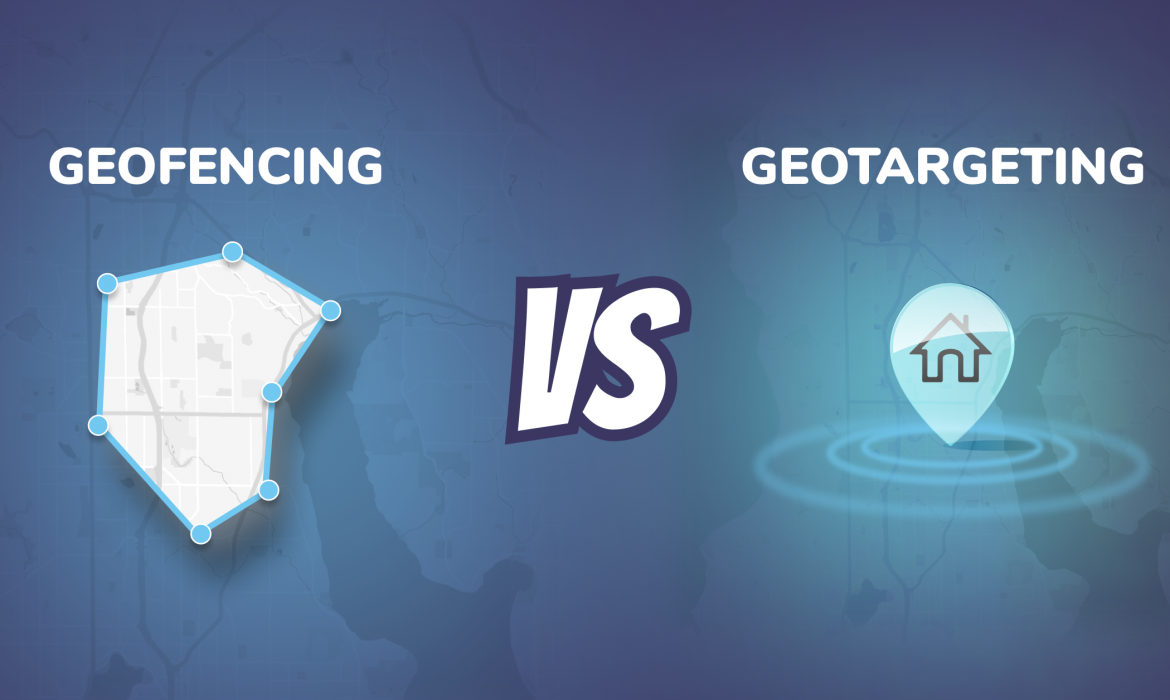
Both Geofencing and Geotargeting are types of Location-Based Marketing, but there are important differences between these two targeting tools. In this article, we will clarify the differences between Geotargeting and Geofencing to give you a better understanding of Location-Based Marketing.
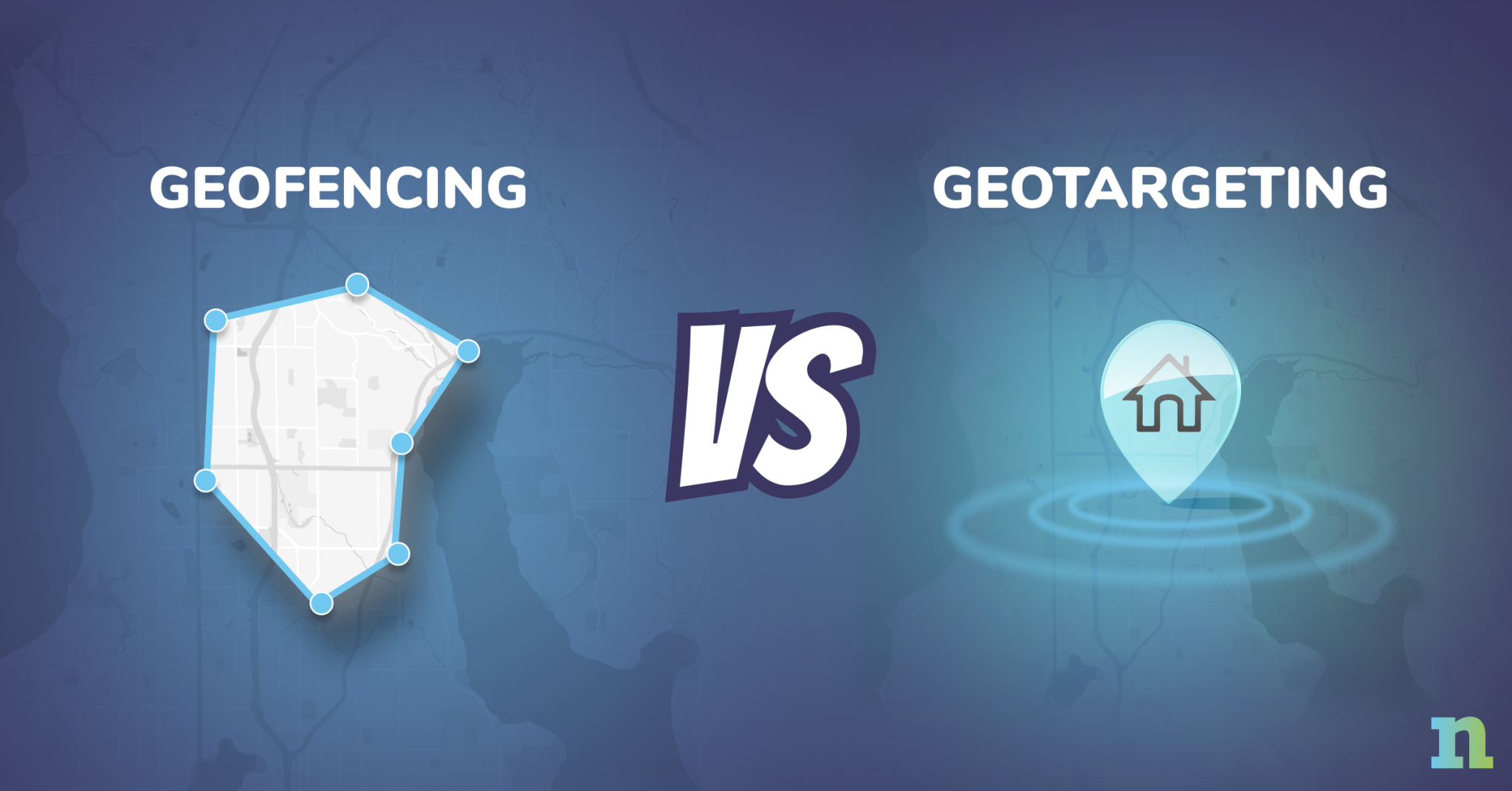
Marketing terms can get a little confusing especially when multiple terms fall under the same category. Location-Based marketing is one of the categories that have a lot of specific terms, suggestions, and tactics.
Geotargeting and Geofencing are one of them, and naturally, people are having a hard time trying to understand the differences between these two terms. Before we sort out the differences, let’s get to know each of them closer.
Geofencing vs. Geotargeting: Understanding the Key Differences
What is Geotargeting?
Geotargeting involves targeting customers based on their location and behavior, making it more precise and tailored to each customer. This technique involves two key actions, first is to identify customers who are located within a specific geographic area, and second is to refine the targeting of these customers based on their behaviors and interests.
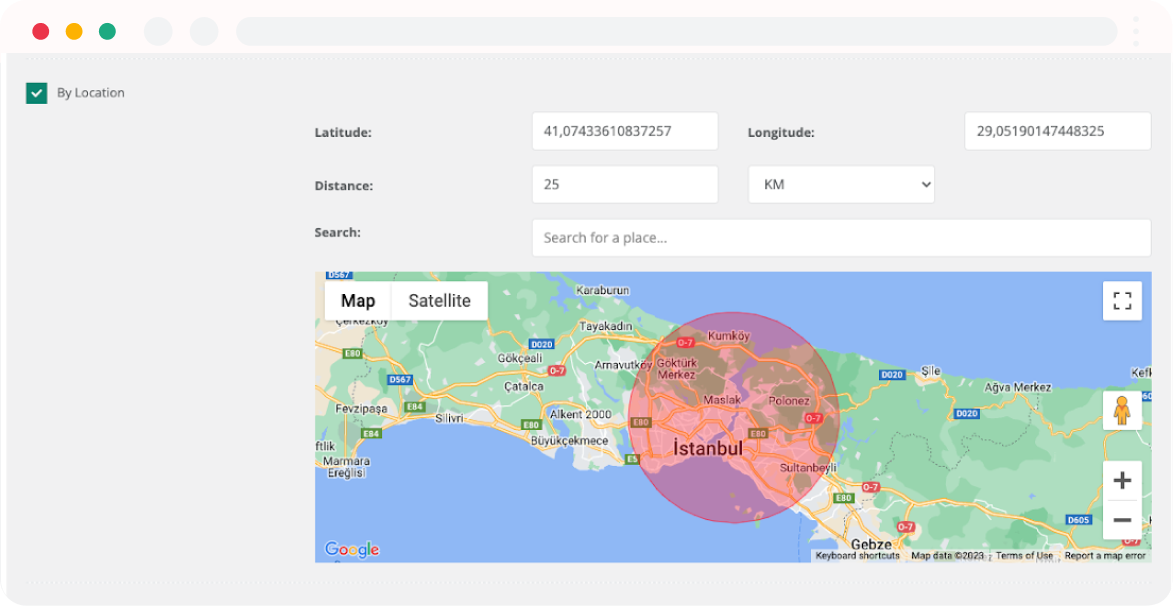
Geotargeting aims to deliver the right message to the right person at the right time and involves capturing the IP address of devices from a particular location. Once the user’s location is identified through their IP address, Wi-Fi, or GPS – the data is saved to servers and can be used to customize the content the user views. The key here is to tailor the message to the user’s location, interests, behaviors, and needs.
For example, say you order frequently from a food delivery app and that app has access to your location. They expanded their services and now they also offer come-and-get-it options if you want to save some money. On your way home, you get a notification saying you can use 30% off if you order from a nearby pizza shop and come and get the order yourself. This is an example of Geotargeting. The brand combined your previous orders, your location, and your preferences in one push notification to capture your attention.
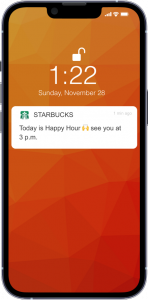
What is Geofencing?
Geofencing is a technique in location-based marketing that uses GPS, Wi-Fi, Cellular Data, or RFID (frequency identification) to create a virtual “fence” around a particular geographic area.
Geofence technology is simply a technology that enables potential customers to receive location-based messages on their phones as soon as they enter the area determined by the brand.
Often used by businesses to target customers in specific locations with relevant and personalized promotions or offers, Geofencing allows marketers to trigger a notification, message, advertisement, SMS, or email.
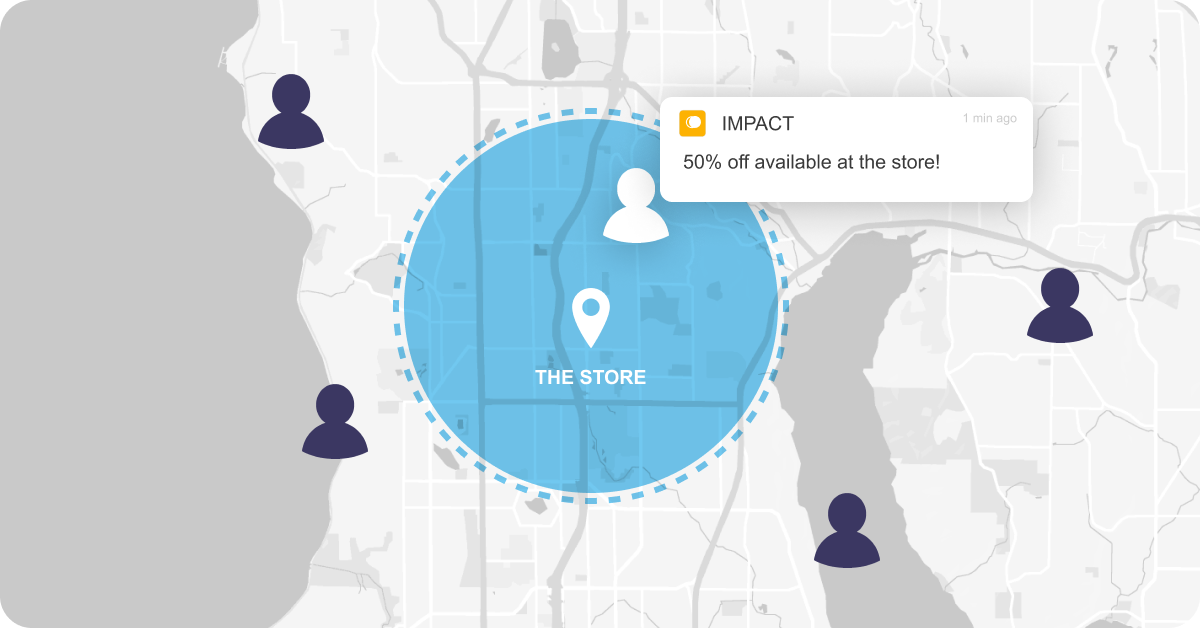
How Businesses Benefit from Geofencing and Geotargeting
Both Geofencing and Geotargeting can be helpful for companies that want to increase their conversion, revenue, and engagement. Since Geotargeting and Geofencing both allow businesses to reach customers who are physically close to their locations, using these techniques can lead to higher conversion rates and sales.
When used correctly, both techniques help businesses connect with their customers at the right time and increase the chances of your customers visiting your stores. With Geofencing and Geotargeting, you can also get real-time data about your target audience and your customers, resulting in getting information about buyer personas.
Moreover, when Geofencing and Geotargeting are combined with personalization, this can result in maximized customer experiences and an increase in both sales and engagement.
Both techniques offer competitive advantages by reaching customers in specific locations and offering personalized content and promotions that their competitors may not be able to have.
While these two techniques have common benefits, they have some different benefits for each technique. For example, in Geofencing, with precise location targeting, businesses with physical stores can send personalized notifications to their customers and advertise their sales, events, or promotions that are specific to each location. On the other hand, Geotargeting sets a broad geographic boundary like a town, or a country, which can result in broader campaigns rather than tailored to each specific location.
What's the Difference Between Geofencing and Geotargeting?
Before we start to go into detail about the differences between Geofencing and Geotargeting, we should start by saying that the differences between these two technologies can differ from one provider to another. So, brands and services must do their research well before reaching an agreement.
While Geofencing works on much narrowed down and more focused areas by setting a virtual fence around a specific geographical location, Geotargeting works by setting a broad geographic boundary like on a city, town, or country. Geofencing can be in different ranges from company to company. Usually, the technology captures 50 to 200 meters.
Geofencing uses GPS, Wi-Fi, cellular data, and so on while Geotargeting depends on the user’s IP address. Geofencing is normally used by event agencies, advertisers, or business owners while Geotargeting can be used in every kind of business.
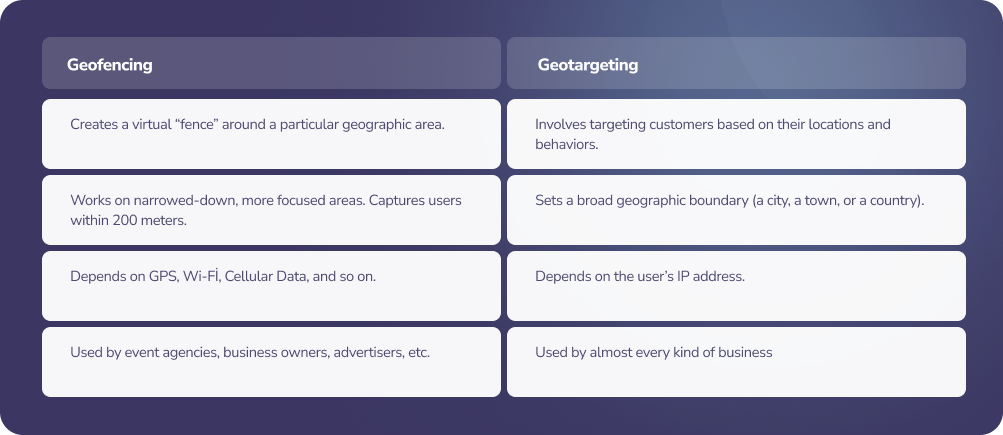
How to Use Geofencing?
To use geofencing in your marketing campaigns, you need to follow some steps:
Define your target area: Determine the specific geographic area where you want to set up your geofence. This could be around your business location, a competitor’s store, or a popular venue.
Set up your triggers: Determine what action to take when a user enters or exits the geofenced area. This could be sending a push notification, creating a journey, sending push notifications, in-app messages, SMS, displaying an advertisement, or tracking user behavior.
Create your marketing campaign:Design your marketing campaign, message, promotion, or offer that will be delivered to users who enter or exit the geofenced area.
Launch your campaign: Launch your campaign and track the results to measure its effectiveness. Make adjustments as necessary to optimize your geofencing strategy.
When to Use Geofencing?
Geofencing is useful for digital marketers who want to target a specific geographic location. It is useful if:
If you have a physical store. Geofencing is one of the most effective targeting tools where you can show your ads. This allows you to set specific geographic parameters for your ads and gives potential customers a place to visit.
If you want to increase conversions quickly. If you’re running a limited-time offer or in-store sale, geofencing can help you get conversions more quickly and increase foot traffic that leads to sales.
If you want to attract your competitor’s customers. You can create a geofence around your competitor’s store and offer discounts or promotions to entice their customers to visit your store instead.
Examples of Geofencing
Sephora, a personal care and beauty products company uses Geofencing technology in shopping malls and venues with a clear push notification and a great incentive. The company sends out push notifications to its customers when they enter the shopping mall, or the geofenced area, with a message that encourages them to visit the physical store to get a free mini makeover.
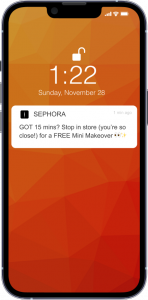
Starbucks also uses Geofence technology to reach out to its customers with push notifications that encourage customers to visit the store to get discounted drinks. Another feature in their Mobile Order & Pay application uses proximity to a store and allows customers to place an order before entering the physical store. Thanks to their Mobile Order & Pay application, customers save time and the brand creates great loyalty.
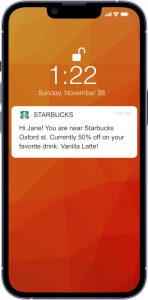
Geofencing Features by Netmera
Even though we’ve talked about Geofence in a broad way, there are many different features with different companies that offer Geofence technology. In this chapter, we will talk about how we make things different at Netmera.
First of all, Netmera captures users within 200 meters which gives us a great advantage compared to our competitors. Another advantage is that we allow our users to upload store information in bulk with a single document, which makes brands’ jobs very easy considering that some brands have more than 3000 branches all over a country, or the world.
Unlike its competitors, Netmera’s Geofencing technology offers our customers to create and run endless numbers of Geofencing at the same time, without any error. Our customers are also able to group those Geofences to use it with different campaigns offered to different segments and send out endless push notifications. With Netmera, our customers are able to target their customers to enter or exit the Geofenced area, without any crashes.
For example, let’s say a clothing brand wants to give special discounts to its customers aged 30-50, who are also in the A income group when they enter the shopping mall. Using our Geofence technology, they can segment their customers and create a target customer segment to send out SMS to these customers when they enter the shopping mall. Using Netmera, the clothing brand can create a Geofence and segment different customers within this Geofence successfully.
Another advantage of Netmera’s Geofencing is that we offer an easy way of doing things. With Netmera, you don’t need any location codes to create the Geofence and all you need to do is to draw your Geofenced area on the map. This feature is loved by marketers who don’t have coding experience or knowledge. Lastly, Netmera’s Geofencing is integrated with Google, which is also a great advantage for all Location-Based Marketing campaigns a brand wants to automate.
Final Thoughts
Both Geofencing and Geotargeting offer distinct approaches to Location-Based Marketing. Brands and services must choose wisely between these two techniques with a clear understanding of what they expect from each method. Using these two strategies can maximize engagement and help brands with delivering tailored experiences to the right people at the right time.
